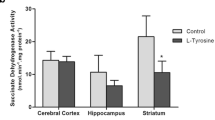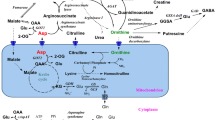Summary
The mechanism of the depletion of several plasma amino acids in PKU has remained unexplained. In the present study, a statistically significant decrease in the plasma concentration of several amino acids was observed 2 h after the intraperitoneal injection of Phe to weanling rats. The pattern was very similar to the one observed in PKU patients. Statistically significant increases in the distribution ratios liver/plasma and, mainly, muscle/plasma ratios accompanied in most of the cases the corresponding decreases in plasma concentrations. Equimolar injection under the same conditions of the non-insulinogenic transport system L analogue, the a(±) isomer of the 2-amino-norbornane-2-carboxylic acid, produced, in a parallel effect to Phe, statistically significant increases in the distribution ratios of Ala and Gly, and probably of Pro in muscle, as well as of Ala in liver. These results seem to indicate that the high intracellular Phe attained inhibits the exodus of small neutral amino acids through system L, causing their depletion in plasma and ultimately in the brain. This effect may be additive to the inhibition by Phe of the entry of bulky neutral amino acids at the level of the blood-brain barrier. Further study is needed to assess the relevance of these effects to PKU.
Similar content being viewed by others
References
Antonozzi, I., Carducci, C., Vestri, L., Manzari, V. and Dominici, R. Plasma amino acid values and pancreatic β-cell function in phenylketonuria.J. Inher. Metab. Dis. 10 (1987) 66–72
Betz, A. L. and Goldstein, G. W. Polarity of the blood brain barrier. Neutral amino acid transport into isolated brain capillaries.Science 202 (1978) 225–227
Brunner, R. L., Vorhees, C. V., McLean, M. S., Butcher, R. E. and Berry, H. K. Beneficial effects of isoleucine on fetal brain development in induced phenylketonuria.Brain Res. 154 (1978) 191–195
Choi, T. B. and Partridge, W. M. Phenylalanine transport at the human blood brain barrier. Studies with isolated brain capillaries.J. Biol. Chem. 261 (1986) 6536–6541
Christensen, H. N. Metabolism of amino acids and proteins.Ann. Rev. Biochem. 22 (1953) 233–260
Christensen, H. N. Interorgan amino acid nutrition.Physiol. Rev. 62 (1982) 1193–1233
Christensen, H. N. Where do the depleted plasma amino acids go in phenylketonuria?Biochem. J. 233 (1986) 929–930
Christensen, H. N. Hypothesis: Where the depleted plasma amino acids go in phenylketonuria, and why.Perspect. Biol. Med. 30 (1987a) 186–196
Christensen, H. N. Role of membrane transport in interorgan amino acid flows: Where do the depleted amino acids go in phenylketonuria? In Kaufman, S. (ed.)Amino Acids in Health and Disease: New Perspectives, Alan R. Liss, Inc., New York, 1987b, Vol. 55, pp. 1–16
Christensen, H. N. and Cullen, A. M. Effects of non-metabolizable analogs on the distribution of amino acids in the rat.Biochim. Biophys. Acta 150 (1968) 237–252
Christensen, H. N. and Cullen, A. M. Intensified gradients for endogenous amino acid substrates for transport system L on injecting a specific competitor for that system.Life Sci. 29 (1981) 749–753
Christensen, H. N. and Handlogten, M. E. Interaction between parallel transport systems examined with tryptophan and related amino acids.J. Neural. Transm. Suppl. 15 (1979) 1–13
Christensen, H. N., Streicher, J. A. and Elbinger, R. L. Effects of feeding individual amino acids upon the distribution of other amino acids between cells and extracellular fluid.J. Biol. Chem. 172 (1948) 515–524
Dolan, G. and Golin, C. Phenylketonuria in rats: a model for biochemical studies.Nature (London) 4 (1967) 916–917
Efron, M. L., Song Kong, E., Visakorpi, J. and Feller, F. X. Effects of elevated plasma phenylalanine levels on other amino acids in phenylketonuric and normal subjects.J. Pediatr. 74 (1969) 399–405
Erikson, S., Hagenfeldt, L. and Wahren, J. A comparison of the effects of intravenous infusion of individual branched chain amino acids on blood amino acid levels in man.Clin. Sci. 60 (1981) 95–100
Fajans, S. S., Floyd, J. S. Jr., Knopf, R. F. and Conn, J. W. Effects of amino acids and proteins on insulin secretion in man.Recent Progr. Horm. Res. 23 (1967) 617–662
Fukagawa, N. K., Minaker, K. L., Young, V. R. and Rowe, J. W. Insulin dose-dependent reductions in plasma amino acids in man.Am. J. Physiol. 250 (1986) E13-E17
Huether, G., Schott, K., Sprotte, U., Thoemke, F. and Neuhoff, V. Regulation of the amino acid availability in the developing brain. No physiological significance of amino acid competition in experimental hyperphenylalaninemia.Int. J. Dev. Neurosci. 2 (1984) 43–54
Huether, G. Regulation of the free amino acid pool in the brain: a lesson learned from experimental phenylketonuria. In Kaufman, S. (ed.)Amino Acids in Health and Disease: New Perspectives, Alan R. Liss, Inc., New York, 1987, Vol. 55, pp. 107–122
Kaufman, S. Phenylketonuria: Biochemical mechanisms. In Agranoff, B. W. and Aprison, M. H. (eds.),Adv. Neurochem., Vol. 2, Plenum Press, New York, 1977, pp. 1–132
Landgraff, R., Landgraf-Leurs, M. M. C. and Hörl, R.l-phenylalanine induced insulin release and the influence ofd-glucose. Kinetic studies with the perfused rat pancreas.Diabetologia 10 (1974) 415–420
Linneweh, F. and Ehrlich, M. Zur pathogenese des schwachsinns bei phenylketonuria.Klin. Wochenschr. 40 (1962) 225–226
Lowden, J. A. and LaRamee, M. A. Hyperphenylalaninemia: the effect on cerebral amino acid levels during development.Can. J. Biochem. 47 (1969) 883–888
Lowry, O. H. and Hastings, A. B. Histochemical changes associated with aging. I. Methods and calculations.J. Biol. Chem. 143 (1942) 257–269
McKean, C. M. The effect of high phenylalanine concentrations on serotonin and catecholamine metabolism in the human brain.Brain Res. 47 (1972) 469–476
McKean, C. M., Boggs, D. E. and Peterson, N. A. The influence of high phenylalanine and tyrosine on the concentration of essential amino acids in brain.J. Neurochem. 15 (1968) 235–241
Nyhan, W. L., Borden, M. and Childs, B. Idiopathic hyperglycinemia. A new disorder of amino acid metabolism. II. The concentration of other amino acids in plasma and their modification by the administration of leucine.Pediatrics 27 (1961) 539–545
Oldendorf, W. H., Crane, P. D., Braun, L. D., Gosschalk, E. A. and Diamond, J. M. pH Dependence of histidine affinity for blood-brain barrier transport systems for neutral and cationic amino acids.J. Neurochem. 50 (1988) 857–862
Partridge, W. M. and Oldendorf, W. H. Transport of metabolic substrates through the blood brain barrier.J. Neurochem. 28 (1977) 5–12
Perry, T. L., Hansen, S., Tischler, B., Bunting, R. and Diamond, S. Glutamine depletion in phenylketonuria: possible cause of mental defect.N. Engl. J. Med. 282 (1970) 761–766
Pratt, O. E. A new approach to the treatment of phenylketonuria.J. Ment. Def. Res. 24 (1980) 203–217
Scriver, C. R. and Clow, C. L. Phenylketonuria: Epitome of human biochemical genetics.N. Engl. J. Med. 303 (1980) 1336–1342
Sershen, H., Debler, E. A. and Lajtha, A. Alteration of cerebral amino acid transport processes. In Kaufman, S. (ed.)Amino Acids in Health and Disease: New Perspectives, Alan R. Liss, Inc., New York, Vol. 55, 1987, pp. 87–104
Shotwell, M. A., Kilberg, M. S. and Oxender, D. L. The regulation of neutral amino acid transport in mammalian cells.Biochim. Biophys. Acta 737 (1983) 267–284
Snyderman, S. E., Sansaricq, C., Norton, P. M. and Castro, J. V. Plasma and cerebrospinal fluid amino acid concentrations in phenylketonuria during the newborn period.J. Pediatr. 99 (1981) 63–67
Tager, H. S. and Christensen, H. N. Hypoglycemic action of 2-aminonorbornane-2-carboxylic acid in the rat.Biochem. Biophys. Res. Commun. 44 (1971) 185–191
Tager, H. S. and Christensen, H. N. 2-Aminonorbornane-2-carboxylic acid. Preparation, properties and identification of the four isomers.J. Am. Chem. Soc. 94 (1972) 968–972
Tourian, A. and Sidbury, J. B. Phenylketonuria and hyperphenylalaninemia. In Stanbury, J. B., Wyngaarden, J. B., Fredrickson, D. S., Goldstein, J. L. and Brown, M. S. (eds.)The Metabolic Basis of Inherited Disease. 5th edn., McGraw Hill, New York, 1983, pp. 270–286
Voorhees, C. V., Butcher, R. E. and Berry, H. K. Progress in experimental phenylketonuria: a critical review.Neurosci. Biobehav. Rev. 5 (1981) 117–190
Wade, L. A. and Katzman, R. Synthetic amino acids and the nature ofl-dopa transport at the blood brain barrier.J. Neurochem. 25 (1975) 837–842
Wilkinson, L. SYSTAT: The system for statistics. SYSTAT, inc., Evanston, IL, 1986
Zanic-Grubisic, T. and Lipovac, K. Disturbances of amino acid transport in rats with experimental hyperphenylalaninemia.J. Inher. Metab. Dis. 4 (1981) 105–106
Author information
Authors and Affiliations
Rights and permissions
About this article
Cite this article
de Cespedes, C., Thoene, J.G., Lowler, K. et al. Evidence for inhibition of exodus of small neutral amino acids from non-brain tissues in hyperphenylalaninaemic rats. J Inherit Metab Dis 12, 166–180 (1989). https://doi.org/10.1007/BF01800722
Received:
Accepted:
Issue Date:
DOI: https://doi.org/10.1007/BF01800722




